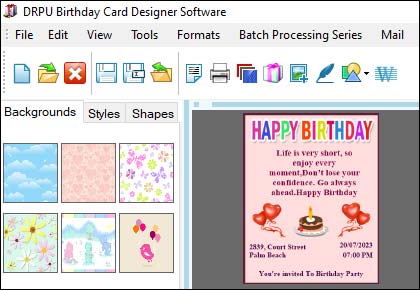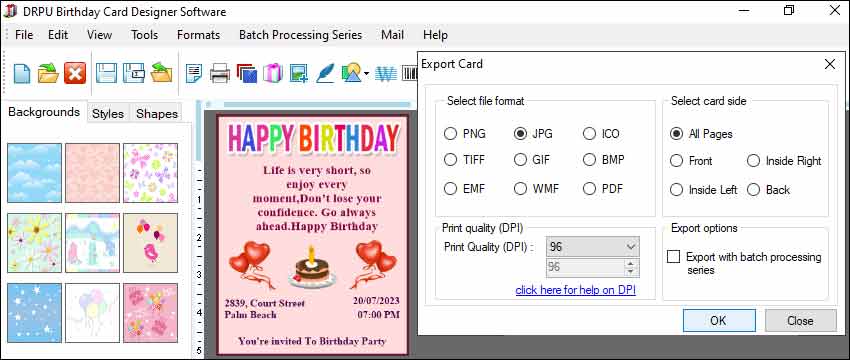Some Best Practices of Designing Birthday Card

-
Use High-Quality Images
One of the most important things to keep in mind when designing birthday cards for print is to use high-quality images. Images that look great on a computer screen may not necessarily look good when printed. Make sure that the images you use are high resolution (at least 300 dpi) and that they are in the correct file format (such as JPEG or PNG).
-
Use CMYK Color Mode
When designing for print, it's important to use the CMYK color mode. CMYK stands for Cyan, Magenta, Yellow, and Key (which is black), and it is the color mode used by most professional printing presses. Using CMYK colors will ensure that the colors in your design look the same when printed as they do on your computer screen.
-
Design in the Correct Size
Make sure that you design your birthday card in the correct size for printing. Most printers have standard paper sizes, such as 8.5 x 11 inches or A4. You should design your birthday card to fit within these standard sizes, so that it will be easy to print and cut.
-
Use Bleed and Margin Guides
Bleed and margin guides are important when designing for print. Bleed is the area of the design that extends beyond the edge of the final product, to ensure that there are no white edges after cutting. Margin guides are the safe areas within the design where important elements (such as text) should be placed to avoid being cut off. Most design software should have the option to add bleed and margin guides, so make sure to use them.
-
Keep the Design Simple: When designing birthday cards for print, it's important to keep the design simple. A cluttered or busy design can be overwhelming and may not print well. Focus on the essential elements, such as the message, images, and color scheme.
-
Pay Attention to Typography: Typography is an important aspect of any design, but it's especially important when designing for print. Make sure to choose a font that is easy to read and that looks good at different sizes. Avoid using too many different fonts, as this can make the design look cluttered and confusing.
-
Test Print Your Design: Before printing a large batch of birthday cards, it's a good idea to test print your design. Print a few copies on your home printer to make sure that the colors, images, and text look good when printed. This will also give you a chance to make any necessary adjustments before sending the design to a professional printer.
Import and Export Birthday Card Designs using Birthday Card Designer Software
Designing birthday cards using software is a popular trend in today's digital era. With the help of birthday card designing software, you can create beautiful and personalized cards for your loved ones. These software programs offer a wide range of features and tools that help you create designs from scratch or modify existing templates. Once you have created a birthday card design, you may want to import or export it for various reasons, such as printing or sharing it with others.
In this article, we will explain how to import and export birthday card designs using birthday card designer software.
-
Importing Birthday Card Designs:
Importing a birthday card design into your birthday card designing software is a straightforward process. Depending on the software you are using, the steps may vary slightly, but the overall process is the same.
-
Step 1: Open the software
Open the birthday card designing software on your computer.
-
Step 2: Click on "File"
Click on the "File" option from the menu bar.
-
Step 3: Click on "Import"
Select "Import" from the drop-down menu.
-
Step 4: Choose the file
Select the file that you want to import from your computer.
-
Step 5: Click on "Open"
Click on the "Open" button to import the file.
-
Step 6: Edit the design
After importing the file, you can edit the design as per your requirements.
-
Step 1: Open the software
-
Exporting Birthday Card Designs:
Exporting a birthday card design from your birthday card designing software is also a simple process. Depending on the software you are using, the steps may vary slightly, but the overall process is the same.
-
Step 1: Open the software
Open the birthday card designing software on your computer.
-
Step 2: Click on "File"
Click on the "File" option from the menu bar.
-
Step 3: Click on "Export"
Select "Export" from the drop-down menu.
-
Step 4: Choose the file type
Select the file type in which you want to export the design. The most common file types for birthday card designs are JPEG, PNG, PDF, and SVG.
-
Step 5: Choose the location
Choose the location on your computer where you want to save the exported file.
-
Step 6: Click on "Export"
Click on the "Export" button to export the file.
-
Step 1: Open the software
Benefits of Importing and Exporting Birthday Card Designs
Importing and exporting birthday card designs have many benefits, such as:
-
Time-saving: Importing a pre-designed birthday card template can save you a lot of time compared to designing it from scratch. Similarly, exporting a design can help you quickly share it with others without having to recreate it.
-
Customization: By importing a design, you can modify it to suit your preferences. Similarly, exporting a design allows you to share it with others who can also modify it as per their requirements.
-
Quality control: By exporting a design, you can ensure that the quality of the design remains intact. For example, if you need to print the design, exporting it in the appropriate file format ensures that the design is of high quality.
-
Collaboration: Importing and exporting designs allow you to collaborate with others. You can import a design from your colleague and edit it as per your requirements. Similarly, you can export a design and share it with your team members for their input.
➽In conclusion, importing and exporting birthday card designs is a simple process that can save you time and effort. Most birthday card designing software programs allow you to import and export designs in various file formats, making it easy to share and modify them. By importing and exporting designs, you can customize them as per your requirements and collaborate with others.
Common File Formats and Ensure Compatibility

There are several common file formats used for birthday card designs, including JPEG, PNG, PDF, and PSD. Each format has its own advantages and disadvantages, and choosing the right one will depend on the specific requirements of your design project.
-
JPEG (Joint Photographic Experts Group) is a compressed image file format that is widely used for web graphics and digital photography. JPEG files can be easily shared and uploaded online, and they are compatible with most digital devices and software programs. However, JPEG files are not ideal for designs that require high levels of detail or precision, as the compression process can result in loss of image quality.
-
PNG (Portable Network Graphics) is a popular file format for graphics that require transparency, such as logos and icons. PNG files use lossless compression, which means that they retain the original image quality without losing any data. This makes PNG files larger than JPEG files, but they are still compatible with most digital devices and software programs.
-
PDF (Portable Document Format) is a versatile file format that can be used for a wide range of designs, including birthday cards. PDF files are commonly used for documents that require printing, as they preserve the formatting and layout of the original document. PDF files can also be easily shared and viewed on most digital devices and software programs.
-
PSD (Photoshop Document) is a file format used by Adobe Photoshop, a popular graphics editing software program. PSD files allow designers to work with multiple layers, making it easier to create complex designs and make changes to specific elements of the design. However, PSD files are not compatible with all software programs and may require additional conversion steps before they can be shared or printed.
When creating a birthday card design, it is important to consider the specific requirements of the printing method and equipment that will be used to produce the final product. This includes factors such as color space, resolution, bleed, and trim.
-
Color space refers to the range of colors that can be displayed or printed. RGB (Red, Green, Blue) is a color space used for digital designs and is commonly used for web graphics and digital printing. CMYK (Cyan, Magenta, Yellow, Key) is a color space used for print designs and is optimized for printing on paper. When creating a birthday card design, it is important to use the appropriate color space to ensure that the colors are accurately represented in the final product.
-
Resolution refers to the amount of detail in an image and is measured in pixels per inch (ppi) for digital designs and dots per inch (dpi) for print designs. When creating a birthday card design, it is important to use a resolution that is appropriate for the intended use of the design. For example, a design that will be printed at a large size will require a higher resolution than a design that will be viewed on a digital screen.
-
Bleed refers to the area of the design that extends beyond the trim edge. This is necessary to ensure that the design extends all the way to the edge of the final printed product. When creating a birthday card design, it is important to include bleed in the design to ensure that the final product looks professional and polished.
-
Trim refers to the final size of the printed product after it has been trimmed to remove the excess paper from the bleed. When creating a birthday card design, it is important to ensure that the design is sized correctly to accommodate the trim size and any necessary bleed.
➽In conclusion, To ensure compatibility with different printing methods and equipment, it is important to follow the specific guidelines provided by the printer or printing service. This may include requirements for file format, color space, resolution, bleed, and trim. It is also important to carefully review the design before submitting it for printing to ensure that it meets all of the necessary requirements and will produce a high-quality final product.